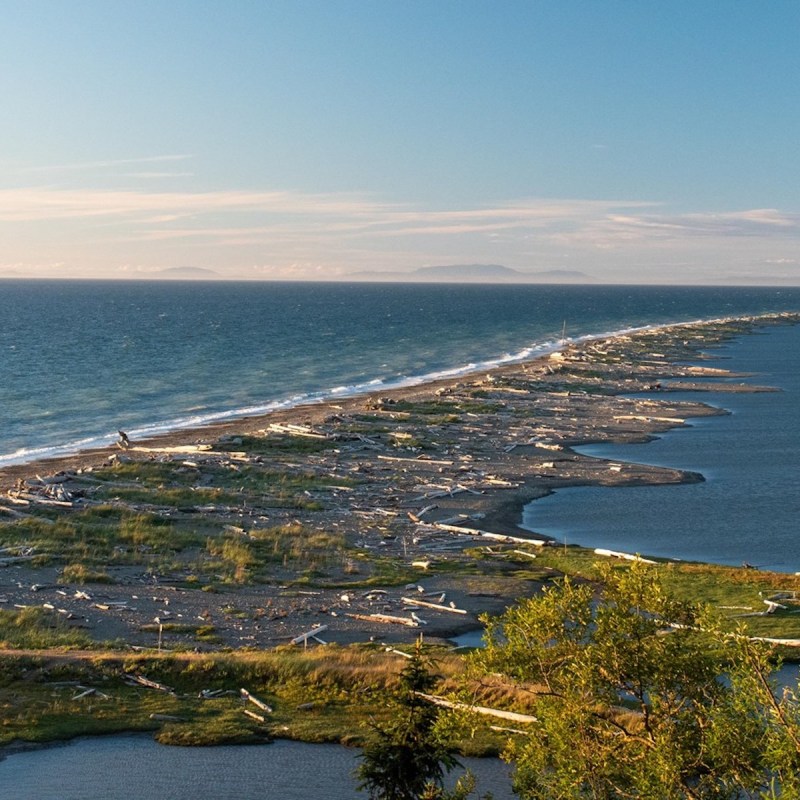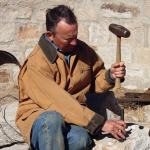
Take a walk on the wild side when you visit the Dungeness National Wildlife Refuge.
Videos by TravelAwaits
Jutting out 5 miles into the choppy waters of the Strait of Juan de Fuca — an inland arm of the Pacific Ocean — is the often fog-shrouded Dungeness Spit located on Washington State’s remote Olympic Peninsula.
Get ready to experience a wild and often windy adventure of walking on a slender ribbon of land surrounded on two sides by salt water amid driftwood logs washed ashore from the sea. The entire spit is part of the Dungeness National Wildlife Refuge and is the longest, natural sand spit in the U.S.
My wife and I first visited the refuge years ago and recently traveled there to renew old memories from that earlier journey. Our trip began with a drive from Seattle to the town of Sequim — pronounced squim — located just a few miles from Dungeness Spit. The drive takes 2–3 hours depending on the route you choose. Do a Google Map search for Seattle–Sequim and select from several choices.
To savor your experience, here are four exciting reasons to visit this out-of-the-way wildlife refuge.
Our lodging was hosted by the Juan de Fuca Cottages but all opinions are my own.
1. Excellent Birding Opportunities
Spring and fall are excellent times to enjoy the scenic Olympic Peninsula and explore this isolated corner of Washington, far from the crowds and traffic congestion of the summer months. Located between Port Angeles and Sequim in the shadow of the lofty Olympic mountain range, the refuge is a place to indulge your fancy with birdwatching, photography, or hiking while exploring a federally managed site that protects a wide variety of birds and marine life.
During the semi-annual migration, you can see large flocks of long-distance flyers as they follow ancient, aerial highways flown by countless generations of their species. The birds stop at the refuge for food and rest before resuming their instinctual journeys in search of safe havens to mate, build nests, and hatch their chicks.
Avid birders may spot loons, cormorants, and numerous other waterfowl species. Shorebirds include sandpipers, greater and lesser yellowlegs, and dunlins. Seabirds that stop over at Dungeness are puffins, Caspian terns, and pigeon guillemots. The refuge protects the critical winter habitat for its most famous visitor, the brant, a small sea goose easily identified by its black head and white “necklace.” Several thousand of these distinctive birds spend the winter in the eelgrass and kelp beds of the sheltered, leeward portion of the spit. These and other species are routinely observed during the migration seasons. The refuge is also home to over 200 species of birds, 29 mammals, and 26 types of fish.
2. Wildlife Encounters
While birding is a popular passion for many refuge visitors, there are also opportunities to see a wide variety of wildlife. Harbor seals are often observed lulling about just off shore. They are curious, intelligent animals and will often stare directly at you and seem to ponder what all of these strange two-legged creatures are doing here.
If you’re lucky, you may have the rare chance to view orcas up close; they are occasionally spotted from the spit. These marine mammals can easily be identified by their large size and distinctive, tall dorsal fin. Gray whales have also been spotted during their northern migration — February to June — while feeding on ghost shrimp.
Pro Tip: When observing wildlife, remember some simple guidelines: Respect their space, remain 200 yards (two football fields) away, and use binoculars to bring them “up close.” Carry a field guide for easy identification and keep voices down when approaching wildlife as sound carries easily across water.
3. Hiking
One of the unique hiking opportunities available in the Pacific Northwest is the 11-mile round-trip hike to the end of the spit. It provides a rare chance to venture out into the open water of the strait while feeling the sting of salt water spray on your face. Plodding through the beach sand, you may see giant ocean-going freighters sliding by so close that their crews are often visible working on deck.
The spit extends outward in a slender, northeastern arc. Its highest point is barely 6 feet above the water, and during high tides, it narrows to less than 50 feet in width.
While the walk is leisurely, you should prepare by first checking the weather conditions for the Port Angeles, Washington, national forecast area.
During our walk, we noticed driftwood piled in the center of the spit. These piles provide a sheltered habitat for several species of grasses. The grasses and jumbles of large and small logs are essential to the continuation of the spit. They serve as anchors for the shifting sand washed up by the incessant, erosive action of wind and waves, and they provide shelter and food for migrating birds.
Dungeness National Wildlife Refuge is open daily from sunrise to sunset. If you plan on hiking the round-trip to the lighthouse, be sure to allow 4–6 hours to complete your trip. Take layered clothing, rain gear, water, and a snack.
Pro Tip: The hike to the lighthouse is best done during periods of low tide. Check the Dungeness Tides table for dates and times of high and low tides. Also, hiking is only allowed on the north — windward — side of the spit as the south side is critical habitat for many wildlife species.
4. New Dungeness Lighthouse
At the far end of the narrow peninsula, a historic Coast Guard lighthouse continues to provide a welcome beacon for ships navigating the often difficult conditions of the strait.
The lighthouse, built in 1857, was staffed by light keepers until 1976, when it became fully automated, and is now managed by New Dungeness Lighthouse, a nonprofit organization dedicated to preserving the legacy of this historic landmark. Maintenance and operation of the light, however, are still the responsibility of the U.S. Coast Guard. This change — although somewhat less romantic than year-round, live-in keepers — is far less expensive to keep the light burning brightly.
Pro Tip: An exciting feature of this lighthouse is the rare opportunity to stay for a week in the keeper’s house while working as a volunteer to help maintain the facility grounds and give guided tours to visitors. Check their website for details on volunteer opportunities.
Tips For Exploring Dungeness Spit
When exploring the spit, you may wonder just how it formed. Dungeness Spit is the result of the erosion of sandy cliffs along the peninsula. Waves pounding against the cliffs cause them to constantly slough off into the water. These sediments are then carried east by currents to pile up in the long, thin sand bar.
Walking the spit is a study in contrasts. On the windward side, the prevailing winds can tumble the surf into 7-foot breakers. These powerful waves give visitors a sense of the force and beauty of nature.
During a winter storm, the sound of the waves breaking on the narrow beach can be deafening and a bit intimidating. On a calm day, they slap the sand with a melodic rhythm inspiring a sense of peace and serenity. The leeward side of the spit, however, is protected from the fierce wind and the offshore water resembles a placid lagoon with sea birds floating on the glassy-smooth surface.
The entire trip from almost anywhere in northern Puget Sound can be done in 1 long day, but I suggest taking several days to savor the experience. If you decide to make a longer trip, overnight accommodations can be secured in either Sequim or nearby Port Angeles.
Where To Stay In The Area
We stayed at the charming Juan de Fuca Cottages near Sequim, just across the water from Dungeness Spit. The cottages are a tasteful blend of older architectural style with a full range of modern conveniences — jetted tub, full kitchen, and a comfortable queen bed.
Camping space at the refuge is found at the adjacent Dungeness Recreation Area managed by Clallam County. Availability changes seasonally, so check their website for current information.
Dungeness Spit offers a chance to experience the exhilaration of being out in the waters of the strait without the luxury of a boat. Feel the power of the sea from a safe vantage. Visit the wildlife refuge and Dungeness Spit to broaden your sense of adventure and feel the thrill of being close to the wind-swept water while walking on a thin strip of sand. You also have an excellent opportunity to see the many species of wildlife that call it home. Come away with a greater appreciation of the often subtle yet powerful natural forces that meet on this lonely strip of land. Hiking the spit is a memorable experience and an exhilarating adventure.
